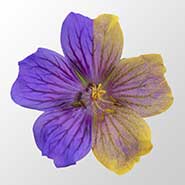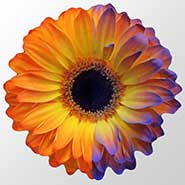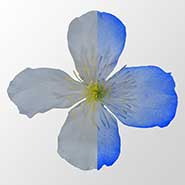|

21 February 2013
from
UniversityOfBristol Website
Various flowers
left: Geranium magnificum;
center: Gerbera hybrida; right: Clematis armandii
showing a
composite of immediately before and after application of charged
powder paint.
The pattern of
powder deposition reveals the shape of the electric field.
Image by Dominic Clarke and Daniel Robert
Flowers' methods of communicating are at
least as sophisticated as any devised by an advertising agency,
according to a new study, published today in Science Express by
researchers from the University of Bristol.
However, for any advert to be
successful, it has to reach, and be perceived by, its target
audience. The research shows for the first time that pollinators
such as bumblebees are able to find and distinguish electric signals
given out by flowers.
Flowers often produce bright colors,
patterns and enticing fragrances to attract their pollinators.
Researchers at Bristol's
School
of Biological Sciences, led by Professor
Daniel Robert, found that
flowers also have their equivalent of a neon sign - patterns of
electrical signals that can communicate information to the insect
pollinator. These electrical signals can work in concert with the
flower’s other attractive signals and enhance floral advertising
power.
Plants are usually charged negatively
and emit weak electric fields. On their side, bees acquire a
positive charge as they fly through the air. No spark is produced as
a charged bee approaches a charged flower, but a small electric
force builds up that can potentially convey information.
By placing electrodes in the stems of
petunias, the researchers showed that when a bee lands, the flower’s
potential changes and remains so for several minutes. Could this be
a way by which flowers tell bees another bee has recently been
visiting?
To their surprise, the researchers
discovered that bumblebees can detect and distinguish between
different floral electric fields.
Also, the researchers found that when
bees were given a learning test, they were faster at learning the
difference between two colors when electric signals were also
available.
How then do bees detect electric
fields? This is not yet known, although the researchers speculate
that hairy bumblebees bristle up under the electrostatic force, just
like one’s hair in front of an old television screen.
The discovery of such electric detection
has opened up a whole new understanding of insect perception and
flower communication.
Dr.
Heather Whitney, a co-author of
the study said:
"This novel communication channel
reveals how flowers can potentially inform their pollinators
about the honest status of their precious nectar and pollen
reserves."
Professor Robert said:
“The last thing a flower wants is to
attract a bee and then fail to provide nectar: a lesson in
honest advertising since bees are good learners and would soon
lose interest in such an unrewarding flower.
"The co-evolution between flowers
and bees has a long and beneficial history, so perhaps it's not
entirely surprising that we are still discovering today how
remarkably sophisticated their communication is."
The research was supported by the
Leverhulme Trust.
Paper
'Detection and learning of
floral electric fields by bumblebees' (Science
DOI: 10.1126/science.1230883)
by Dominic Clarke, Heather Whitney, Gregory Sutton and Daniel
Robert in
Science Express
Bumblebees Sense...
Flowers' Electric Fields
by Ben Aviss
Reporter
21 February 2013
from
BBCNature Website
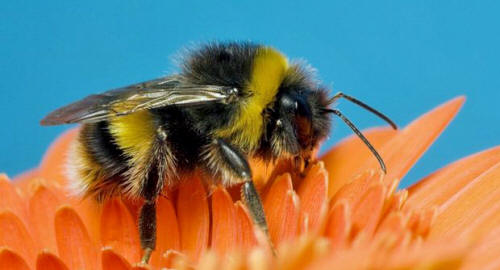
Beyond the
naked eye:
differences in
electric signals provide bees with information about a flower
Bumblebees (Bombus terrestris) can detect flowers' electric fields,
scientists have discovered.
Results indicate floral electric fields improve the bees' ability to
discriminate between different flowers. When used with visual
signals, electrical cues can enhance the bee's memory of floral
rewards.
Researchers suggest this method of signaling provides rapid and
dynamic communication between plants and pollinators. The findings
are published in the online journal
Science Express.
Flowering plants reward pollinators with nectar and pollen in return
for their assistance in the flowers' sexual reproduction.
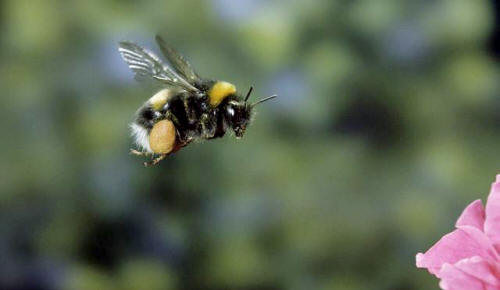
Brilliant bees and
fantastic flowers
Flowers attract pollinators using cues such as bright colors,
patterns and enticing fragrances but this study suggests the
importance of electrostatic information as an additional cue for the
first time.
"Of course it has existed for a long
time but this is a new way we can look at the interactions
between bees and flowers," said Prof Daniel Robert of the
University of Bristol.
"This doesn't throw away any of the
previous work on cues that flowers are using, it adds another
layer on top of that."
Prof Robert and his team were studying
the mechanism of pollen transfer between flowers via an insect
pollinator.
"What the pollen needs to 'know' is
when to 'jump' onto the 'vehicle' - the bee - and when to get
off it. So it's a selective adhesion type of question," Prof
Robert told BBC Nature.
Electric
attraction
The team's investigation highlighted the possible importance of
electrostatic forces.
This is the tip of the
iceberg,
there's so much more that
we haven't seen yet”
Prof Daniel Robert University of Bristol
"We looked at [existing] literature
and realized that the bees were being positively charged when
they fly around, and that flowers have a negative potential.
"There's always this electrical bias around. As a sensory
biologist, suddenly I thought: can the bees sense that?" Prof
Robert said.
Dominic Clarke, one of the lead
authors, designed "fake" electric flowers in a laboratory "flying
arena" to prove that electric fields are important floral cues.
Electric flowers with a positive charge offered a sucrose reward
while those without offered a bitter quinine solution. Bumblebees
were allowed 50 visits in the flying arena and the last 10 visits
showed the bees had learnt to tell the difference between the
flowers.
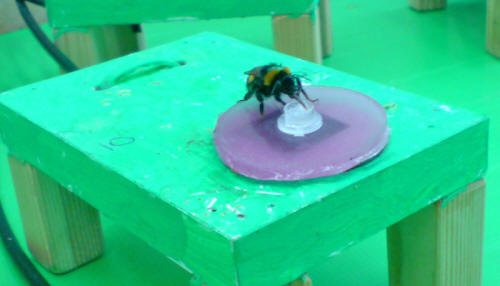
Bumblebee in
laboratory flying arena
Eliminating other
variables in the bee 'flying arena'
When the electric field was turned off,
"the bee goes back to selecting at
random because it hasn't got a way to tell the difference
between them any more," commented Mr Clarke.
"That's how we know it was the
electric field that they were learning."
"Animals are just constantly surprising us as to how good their
senses are. More and more we're starting to see that nature's
senses are almost as good as they could possibly be," Mr Clarke
told BBC Nature.
Prof Robert summed up:
"We know they can detect these
electrostatic fields… this is the tip of the iceberg, there's so
much more that we haven't seen yet."
|

